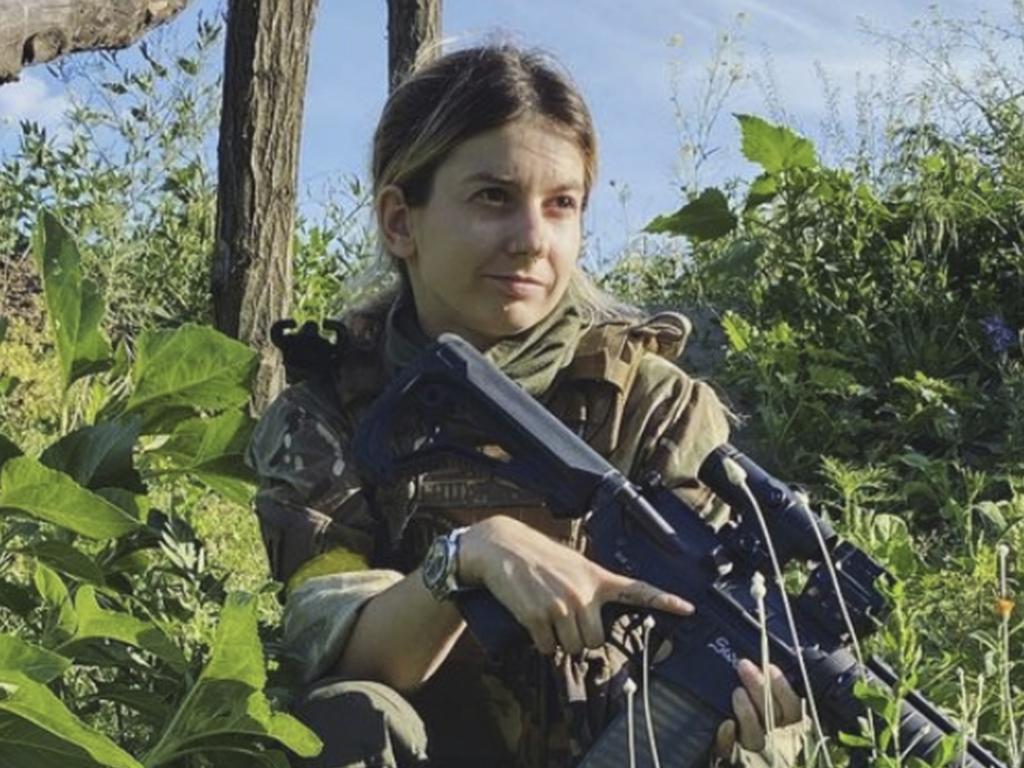The day Australian legionnaire Mick O’Neill’s luck ran out in Ukraine
Mick O’Neill holds his phone to record the last video he will send to his family from Ukraine. Shortly after the Tasmanian truckie-turned-foreign legionnaire will be killed.

Mick O’Neill holds his phone up to record the last video he will ever send home to his family from the frontline of the Ukraine war.
The Tasmanian truckie-turned-foreign legionnaire is taking cover from Russian artillery fire in a tiny village called Molodova. In less than a fortnight, he will be killed in a mortar attack, the first Australian to die in combat in this grim war.
Yet as he shelters in the doorway of a bunker, the 47-year-old is philosophical about the prospect of death.
“If we get a direct hit, she’s all over, but anyway – it’s something,” he says laconically.
Just across the river, Russian forces are regrouping after being driven out of the village days before.
“Our guys have just gone down to the river to pick a fight and I’ll be the one driving them out, potentially with a bit of f..king artillery up me arse,” he says.
“Anyway, guys, war is lovely.”

Less than two months before, the man who would become Australia’s first fatality in the Ukrainian conflict was driving trucks in the remote outback, paying off several debts he incurred following a brief stint living in The Philippines.
The first he had heard of the war, according to family, would have been on the radio during one of his long-haul truck journeys across Western Australia.
Days after Russia’s invasion, O’Neill expressed keen interest in travelling to the front as a volunteer, although members of his family, including a cousin formerly in the SAS, tried to dissuade him.
Fast-forward three weeks, the 47-year-old had sold his possessions, purchased a plane ticket to Germany and reached Ukraine.
He told his siblings in Tasmania he’d arrived to help as a humanitarian aid worker.
In reality, O’Neill had already committed to fighting for the Foreign Legion.
Two weeks after Russia launched its full-scale invasion, Ukraine’s foreign ministry told international media that up to 20,000 volunteers from some 50 countries had already responded to President Volodymyr Zelensky’s call to arms.
At the same time, the Australian government and leaders of the Australian Federation of Ukrainian Organisations were busy warning citizens against travelling to the embattled country, noting that those who decided to fight could face prosecution on their return.
Conflicting reports from fighters on the ground and the government suggest the current number of Australian volunteers serving in the Foreign Legion could range between 200 to 600 personnel.
Larrikin figure
The Australian interviewed several legionnaires who served alongside O’Neill and who agreed to speak only on the condition of anonymity.
A first-hand account of O’Neill’s arrival was captured by a Ukrainian film crew just days before his death on May 24.
“They detained me in Germany for 12 hours [after landing there] because they weren’t allowing me to come into Europe,” O’Neill said.
“I met a Ukraine guy when we were detained at the airport and he said, ‘Well, I’ve got an idea – we can fly into the UK.
“We flew to the UK the next morning and then he bought me a ticket to come to Ukraine.”
Asked why he’d travelled to Ukraine to fight Russians, he replied: “They’re bullies. I just fell in love with the Ukrainian spirit, I guess …
“The Russians are killing innocent people, attacking villages and not targeting military operations.”
O’Neill, who had told family he would be transporting supplies and the wounded, joined his battalion in early March after reporting to a collection point near Lviv, in western Ukraine.
For a fortnight he trained with his battalion at the Yavoriv military base, an area previously used by the Polish army before the Soviet annexation in 1939.
An Australian legionnaire who served in Iraq and Afghanistan met O’Neill on his first day at the military base in March and became instant friends with the Tasmanian. “I recognised the Australian accents out the front of one of the barracks immediately.
“Mick – or ‘Taz’ as we called him – was there with two other Aussies having a cigarette. He was already a very popular, larrikin figure among the battalion.”

Missile attack
O’Neill came to Yavoriv with no combat experience, and his brief time at the facility was devoted to weapons and close quarter training for deployment.
“The problem was at the beginning, in March, when they [Foreign Legion] ramped up fairly quickly, they got some combat veterans and people that had absolutely no military background, who padded out their resumes,” another Australian fighter said.
“We had murderers, rapists, drug addicts and all sorts of different types of people turning up … There was a lot of strange shit that went on. But a lot of that has changed. Most of them were fakes but Mick was never what we called a ‘war tourist’. Like most of us, he was serious – he came with a purpose.”
A week into O’Neill’s training, the Foreign Legion met their first major challenge as Russian forces launched a ferocious bombardment of the Yavoriv military base on March 13.
The missile attack forced O’Neill and other members of his company to scramble into the wooded surrounds of the facility, before evacuating to a second military base near the strategically important city of Rivne, 170km south of the Belarussian border.

A US legionnaire – who served as the battalion’s medical director with O’Neill right up until his death – said the attack on Yavoriv was an early turning point in the development of the Foreign Legion.
“Things were so chaotic during the strike. The Ukrainian command actually told us there were Spetsnaz forces [Russian special forces] outside the gate.
“That turned out not to be correct. It was just bad intel.
“But a lot of people left at that early point as a result of that strike, even seasoned combat veterans who had served in Iraq and Afghanistan decided to leave … They hadn’t seen anything like it before. But Mick decided to stay.”
Following the March attack, O’Neill and his battalion moved south to a new military base in the Rivne region. A month later, after more training and a brief secondment to the battalion’s medical unit, he was on the move again, east towards the front.

Mortar shells
The beginning of the end for O’Neill came in May after his battalion was sent to a new military base in the Kharkiv region, less than 5km from the Russian border.
By the time he arrived, intense fighting between Russian and Ukrainian forces had broken out near the base – an engagement that continues to this day.
“It was Mick’s first real deployment to the frontline when he was taken out,” an Australian legionnaire said, noting there were still some doubts over whether the battalion was ready for combat.
The day he was killed, O’Neill was on patrol.
A small detachment of legionnaires had fanned out from a base near the village of Ternova on May 24, carrying Javelin missiles and digging defensive positions to provide anti-tank support for nearby Ukrainian units.
The detachment soon came under heavy enemy fire, while they attempted to hold their position against superior Russian forces. Without warning, Russian mortar shells rained down on the company from wooded cover, with three soldiers immediately injured in the blast. When the initial fusillade ended, soldiers rushed to O’Neill’s side.

A US legionnaire, who was one of eight soldiers with him, said shrapnel from a mortar attack killed him within minutes, inflicting “catastrophic wounds” and heavy lacerations to O’Neill’s abdominal region.
“There were penetrating shrapnel wounds that hit major blood vessels, but there was also the shockwave effect of the actual explosion, which caused significant internal organ damage because of the sheer force of the blast and his proximity to it,” he said.
“We knew that even if he had been taken immediately into a level one trauma ward, the bleeding was so catastrophic, even with rapid infusing, it would not have been possible to do anything differently. We had people on both sides of him holding his hands. There was a former US marine cradling his head in his arms in his final moments.”

Complex character
The father of three children was a “complex character with a heart of gold”, according to his mother, Elizabeth Rickards, who later praised O’Neill after she learned he’d gone to fight in Ukraine.
Ms Rickards said O’Neill’s motivations were only emboldened after witnessing “the destruction of civilian homes and cities”.
In a final tribute to her son, she wrote: “He went over to help as a volunteer and if you knew him, he wouldn’t have been content not to get fully involved.
“He trained to be a soldier and ended up in the war zone where the Ukraine army came under very heavy fire and Michael’s luck ran out.”






To join the conversation, please log in. Don't have an account? Register
Join the conversation, you are commenting as Logout